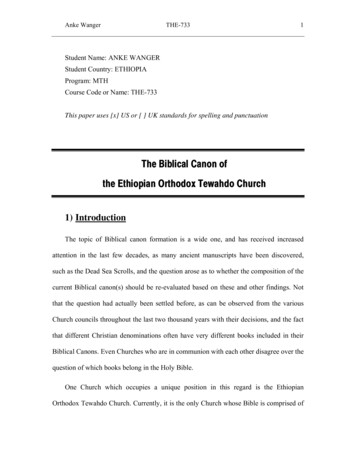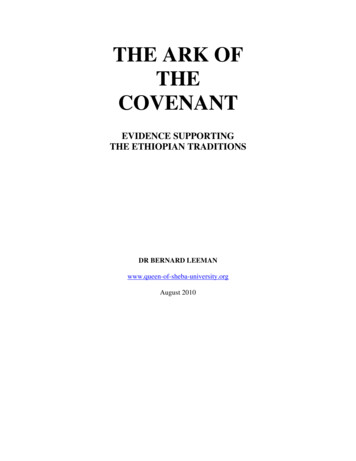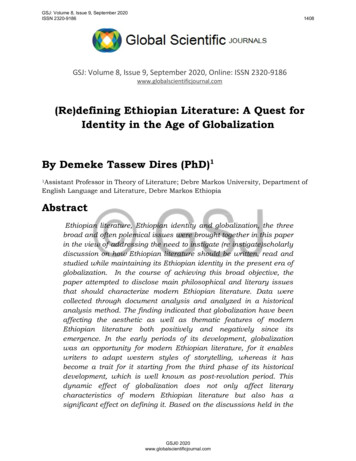
Transcription
chilot.wordpress.comLegal Research MethodsTeaching MaterialPrepared by:Prof (Dr) Khushal Vibhute&Filipos Aynale mPrepared under the Sponsorship of the Justice and Legal SystemResearch Institute2009
chilot.wordpress.comTABLE OF CONTENTSUNIT 1: -----------------------------11.1 ----------------21.2 Law and Society: Mutual Relationship & --------------31.3 Legal System: A System of Norms and Social --------41.4 Role of Law in A Planned Socio-Economic ---------6UNIT 2: LEGAL RESEARCH: AN INTRODUCTION----------------------------------82.1 What is ----102.1.1Meaning of ctives of tion in h and scientific -----------------------142.2 Types of ----152.2.1Descriptive vs. Analytical Research ------------162.2.2Applied vs. Fundamental Research ------------162.2.3Quantitative vs. Qualitative Research ---------172.2.4Conceptual vs. Empirical ---------------------182.3 Research Methods and Research ------------------182.4 What is legal .5 Scope and relevance of legal ---------------------------222.5.1Nature and Scope of Legal -------------------222.5.2Scope of Legal Research in the Common Law System and the Civil Law System------272.6 Importance (Purpose) of legal -------------------------302.6.1Ascertainment of ng inbuilt ‘gaps’ and ------------------312.6.3Determining consistency, coherence and stability of law----------------------------------312.6.4Social auditing of ---------------------------------322.6.5Suggesting reforms in ---------------------------322.7 Legal research by ----------------------------------------34i
chilot.wordpress.com2.7.1By a Legislator ---------------------------------------342.7.2By a 62.7.3By a 72.7.4By a Law Teacher and Student of ------------402.8 Legal research and -------------------------------------442.9 Sources of 462.9.1Primary sources ry rtiary ------------------------------------------- 502.10Major stages in legal research -----------------------512.10.1 Identification and formulation of a research problem-----------------------------------522.10.2 Review of literature ----------------------------542.10.3 Formulation of a hypothesis -----------------562.10.4 Research ---------------------------------------572.10.5 Collection of -----------------------------------582.10.6 Analysis of --------------------------------------592.10.7 Interpretation of ------------------------------592.11 Legal Research in Ethiopia: Perspectives and ----61UNIT 3: DOCTRAINAL AND NON-DOCTRINAL LEGAL RESEARCH---------------------683.1. -------------- 693.2. Doctrinal Legal 1 - ------713.2.2 Aims and Basic Tools of Doctrinal Legal -----733.2.2.1 Aims .2.2.2 Basic ---------------------------------------------74ii
chilot.wordpress.com3.2.3 Advantages and Limitations of Doctrinal Legal 2.3.1 Advantages --------------------------------------803.2.3.2 833.3. Non-Doctrinal Legal Research Or Socio-Legal Research 3.1 -------853.3.2 Aims and Basic Tools of Non-Doctrinal Legal 73.3.2.1 Aims -------------------------------------- ---------873.3.2.2 Basic .3 Advantages and Limitations of Non-Doctrinal Legal Research--------------------------------933.3.3.1 3.3.3.2 943.4. Inter-relation between Doctrinal and Non-doctrinal Legal Research------------------------------97UNIT 4: MODELS OF LEGAL RESEARCH AND CURRENTTRENDS IN LEGAL ------1014.1 Models of legal 24.1.1Evolutive and entificatory and impact -------------------------1034.1.3Projective and ---------------------------------------1074.2 Current trends in legal research inary legal ary legal ----------------------------109iii
chilot.wordpress.com4.2.3Inter-disciplinary legal -----------------------------111UNIT 5: -----------------------------1155.1 ------------1165.2 SOURCES OF 195.2.1 Hunch or 2.2 Findings of others’ -----------------------------------1195.2.3 A theory or a body of ----------------------------1205.2.4 General social --------------------------------------1205.2.5 ------1205.2.6 Personal -------------------------------------------1215.3 CHARACTERISTICS OF A WORKABLE OR USABLE -----------1225.3.1 Hypothesis should be conceptually clear ------1225.3.2. Hypothesis should be ----------------------------1235.3.3 Hypothesis should be empirically testable ----1235.3.4 Hypothesis should be related to available techniques --------------------------------------1245.3.5 Hypothesis should be related to a body of theory or some theoretic-al orientation--1245.4 ROLE OF HYPOTHESIS 1 Role of hypothesis in navigating --------------1265.4.2 Role of ‘tested’ hypothesis ------------------------1275.4.2.1 To test --------------------------------------1275.4.2.2 To suggest new ---------------------------1275.4.2.3 To describe social -------------------1275.4.2.4 To suggest social --------------------------128iv
chilot.wordpress.comUNIT 6 RESEARCH ------------------1306.1 -------------1306.2 Major contents of research ----------------------------1346.2.1 Types of research ----------------------------------1396.3 Role (utility) of research ------------------------------147UNIT 7: SAMPLING TECHNIQUES: RANDOM AND NON-RANDOM----------1517.1 Some key-technical concepts: Population, sub-population,stratification, element, sample, sampling, sampling techniques, sampling-error ----------------------1527.2 Assumptions underlying in -------------------------------------1537.3 Factors to be considered while drawing sample --------------1557.4 Major Sampling Techniques: Random and --------------1567.4.1Random sampling techniques: Types with their relative advantagesand .4.2Non-random sampling techniques: Types with their relativeadvantages and --------------------------157UNIT 8: BASIC TOOLS OF DATA -----1668.1 ------------------1678.2 Interview ---1718.3 ---------------1738.4 ------- --------1788.4.1 Participant observation: Advantages and --1798.4.2 Non-participant observation: Advantages and NIT 9: ANALYSIS AND INTERPRETATION OF DATA------------------------------------1839.1 Doctrinal legal -----1849.1.1 A general Approach to Legal ------------------------------185v
chilot.wordpress.com9.1.2 Doing the Legal research --------------------------------1919.2 Non-doctrinal legal IT 10: WRITING A RESEARCH -----20810.1 Structural layout of research ----------------------------------21110.1.1 The ----21210.1.2 The ------21210.1.3. The -247vi
chilot.wordpress.comUNIT 1INTRODUCTIONAll progress is born of inquiry. Doubt is often better thanoverconfidence, for it leads to inquiry, and inquiry leads to invention.HudsonResearch is the systematic indulgence of one’s curiosity - - - andwhen systematically pursued for the elucidation of events, we call it science.Felix FrankfurterThere is no short-cut to the truth; no way to gain knowledge of the universeexcept through the gateway of scientific method.Karl PearsonSTRUCTURE1.1 Introduction1.2 Law and Society: Mutual Relationship & Interaction1.3 Legal System: A System of Norms and Social System?1.4 Role of Law in A Planned Socio-Economic DevelopmentOBJECTIVESAfter going through the Unit, you will be able to: To familiarize students with the mutual relation and interaction between ‘law’and ‘society’ To explain the social dimension of law To stress the need for legal research To highlight role of law in the socio-economic transformation1
chilot.wordpress.com1.1 INTRODUCTION‘Research’, in simple terms, can be defined as ‘systematic investigation towardsincreasing the sum of human knowledge’ and as a ‘process’ of identifying andinvestigating a ‘fact’ or a ‘problem’ with a view to acquiring an insight into it orfinding an apt solution therefor. An approach becomes systematic when a researcherfollows certain scientific methods.In this context, legal research may be defined as ‘systematic’ finding law on aparticular point and making advancement in the science of law. However, the findinglaw is not so easy. It involves a systematic search of legal materials, statutory,subsidiary and judicial pronouncements. For making advancement in the science oflaw, one needs to go into the ‘underlying principles or reasons of the law’. Theseactivities warrant a systematic approach. An approach becomes systematic when aresearcher follows scientific method.Generally, law is influenced by the prevailing social values and ethos. Most of thetimes, law also attempts to mould or change the existing social values and attitudes.Such a complex nature of law and its operation require systematic approach to the‘understanding’ of ‘law’ and its ‘operational facets’. A systematic investigation intothese aspects of law helps in knowing the existing and emerging legislative policies,laws, their social relevance and efficacy, etc.In this backdrop, the present course on Legal Research Methods intends to acquaintthe students of law with scientific methods of inquiry into law. It also intends to makethem familiar with nature, scope, and significance of legal research. In addition, itendeavors to make them aware of role of legal research in the development of law andlegal institutions, in particular and socio-economic development of the country ingeneral.With these objectives, the course addresses to sources, categories and types of legalresearch. It focuses on legal research methods and tools. It highlights differentdimensions and tools of doctrinal legal research as well as non-doctrinal legal2
chilot.wordpress.comresearch or socio-legal research. In other words, the course strives to instill in the lawstudents basic skill of identifying research problems, planning and executing legalresearch projects and of appreciating the problems associated therewith. It aims atinstilling in them basic research skills so that they can plan and pursue legal andsocio- legal research in future.1.2 LAW AND SOCIETY: M UTUAL R ELATIONSHIP & INTERACTIONLaw does not operate in a vacuum. It has to reflect social values, attitudes andbehavior. Societal values and norms, directly or indirectly, influence law. Law alsoendeavors to mould and control these values, attitudes and behavioral patterns so thatthey flow in a proper channel. It attempts either to support the social system or tochange the prevalent social situation or relationship by its formal processes. Law alsoinfluences other parts of the social system. Law, therefore, can be perceived assymbolizing the public affirmation of social facts and norms as well as means ofsocial control and an instrument of social change. 1 Commenting on theinterrelationship between law and society, Luhman observed:All collective human life is directly or indirectly shaped by law. Lawis, like knowledge, an essential and all pervasive fact of the socialcondition. No area of life-whether it is the family or the religiouscommunity, scientific research is the internal network of politicalparties-can find a lasting social order that is not based on law ---. Aminimum amount of legal orientation is indispensable everywhere. 2Law is not, nor can any discipline be, an insular one. Each rule postulates a factualsituation of life to which the rule is to be applied to produce a certain outcome.Law, in essence, is a normative and prescriptive science. It lays down norms andstandards for human behavior in a set of specified situation(s). It is a ‘rule of conduct1See, Lawrence M Fried mann and Steward Macaulay, Law and Behavioral Science (Bobbs-Merrill Co,Inc, Indianapolis, 1969), Roscoe Pound, Jurisprudence, vol 2 (St Pau l, Minn., West Publishing Co.,USA), and Sir Carleton Kemp A llen, Law in the Making (Oxford, London, 7th edn, 1964) chap IV OnLegislat ion.2Luhman, Sociological Theory of Law (1972, English Translation, 1985) at 1, cited in, 50 MLR 686(1987).3
chilot.wordpress.comor action’ prescribed or formally recognized as binding or enforced by a ‘controllingauthority’. It operates in a formal fashion. It enforces these prescribed norms throughstate’s coercive powers.However, the societal values and patterns are dynamic and complex. These changingsocietal values and ethos obviously make the discipline of law dynamic and complex.Law, therefore, has to be dynamic.Law has acquired a paramount significance in a modern welfare state as an effectiveinstrumentality of socio-economic transformation. It indeed operates as a catalyst forsuch a transformation.Such a complex nature of law and its operation require systematic approach to the‘understanding’ of ‘law’ and its ‘operational facets’. A systematic investigation intothese aspects of law helps in knowing the existing and emerging legislative policies,laws, and their social relevance. It also enables to assess efficacy of law as aninstrument of socio-economic changes and to identify bottlenecks, if any. Law, thus,has a social context. Law without its social context is simply a noteworthy mentalexercise. ‘Law without social content or significance is law without flesh, blood orbowels’. 31.3 LEGAL S YSTEM: A S YSTEM OF NORMS AND SOCIAL S YSTEM?In this background, a system of law can be conceptualized in three principal ways.First, a legal system can be conceived as an aggregate of legal norms. Second, it canbe conceived as systems of social behavior, of roles, statutes, and institutions, asinvolving patterned interactions between the makers, interpreters, breakers, enforcers,and compliers of the norms of law. Third, legal system may be equated with socialcontrol systems, involving differential bases of social authority and power, differentnormative requirements and sanctions, and distinctive institutional complexes.Thus, there are three dimensions or aspects of a lega l system: (i) legal system as anormative system, (ii) legal system as a social system, and (iii) legal system as a3S P Simpson & Ruth Field, Law and the Social Sciences, 32 Va L Rev 862 (1946).4
chilot.wordpress.comcombination of formal and non- formal norms of social control. Each one of thesedimensions of ‘legal system’, however, raise different queries for investigation and setdifferent orbits for inquiry.Legal system, as an aggregate of legal norms, raises a set of typical questions. Aprominent among them are: How is law generated? What forces in society influencedor created particular kinds of law? What makes a system of law out of a vast andheterogeneous mass of normative materials? By what concepts and criteria can weidentify the existence of a legal system? While the second conception of legal systemwarrants a study of institutional behavioral patterns and roles of the lawmakers(Legislature), law interpreters (Judges), law-enforcers (the police), law-breakers(wrongdoers) and law-compliers (law-abiders) and their influence, individual orcumulative, in the legal system and legal processes. The third one addresses to theinter-relationship (supportive or otherwise) between the formal (legal) rules and(informal) non- legal rules (such as religious, indigenous, or customary norms) inshaping law as social control system.Further, it is necessary to recall, in brief, some of the philosophical explanations oflaw as they have a significant bearing on the social dimension or context of law.These explanations look at law in its working and the myths about functioning of lawand truth about its role. 4 The basic tenet of Marxian approach to law is that ‘law’,though social system structures it, is an instrument in the hands of the classes inpower to use it to protect their own interests. The class in power uses law to exploitpowerless classes. While Roscoe Pound insists that law is an instrument of socialengineering. He asserts that law can be an effective tool for establishing an egalitariansocial order.Traditionally, the first dimension of legal system, namely law as a system of norms, isthe domain of academic lawyers; the second one, i.e. law as a system of socialbehavior, is of sociologists, and the third one is of social anthropologists. 5 These threedimensions of a system of law, in ultimate analysis, broadly speak of norma tive4Adam Podgorecki, Law and Society (Routledge & Kegan Paul, London, 1974) 4.Upendra Baxi, Socio-legal Research in India-A Programschrift (Indian Council of Social ScienceResearch (ICSSR), New Delh i, 1975). Reprinted in, S K Verma & M Afzal Wani (eds), LegalResearch and Methodology (Indian Law Institute, New Delhi, 2nd edn, 2001), at pp 656-657.55
chilot.wordpress.comcharacter of law (or perceive law as system of norms) and of social context (orsociology of law) of law. It treats law as a means to define an end. The traditionalperception of law as a system of norms concerns with analytical- linguistic study oflaw while the sociology of law highlights the ‘social context’ of ‘law’.1.4 R OLE OF LAW IN A PLANNED SOCIO-ECONOMIC D EVELOPMENTA contemporary modern state, which endeavors to bring socio-economictransformation envisaged in its Constitution, assigns a cata lyst role to law. It strives tobring such a transformation through a cluster of social welfare legislations enacted inpursuance of its constitutional objectives, policies and perceptions.For example, a careful look at the well-articulated ‘economic objectives’, ‘socialobjectives’, and ‘environmental objectives’ embodied in the FDRE Constitution6reveals laws’ role in accomplishing them. The Government, inter alia, is duty boundto ensure that all Ethiopians get equal opportunity to improve their economicconditions and to promote equitable distribution of wealth among them and to deployland and other natural resources for the common benefit of the People anddevelopment. It has also to make endeavor to protect and promote the health, welfareand living standards of the working population of the country. The Constitution alsoobligates the Government to provide special assistance to Nations, Nationalities, andPeoples least advantaged in economic and social development. The Constitution alsoenvisages Ethiopians access to public health and other basic amenities. It assures themof a clean and healthy environment. All these constitutionally contemplatedprescriptive obviously assign a greater role to ‘law’ in their accomplishment.? Activity 1.1: What relations hip is there between Ethiopian Laws (choosesample laws, such as Constitutional law, Family Law, Comme rcial law, Criminallaw, etc) and the Ethiopian People, Nations and Nationalities? Discuss in groups,being from 2 to 3 students.6See, arts 89- 90 & 92, FDRE Constitution.6
chilot.wordpress.comCHECK YOUR PROGRESS What is the link between law and society? Does law influence society or society influence law? Describe social dimensions of law Is law normative in character or a part of social system? Comment upon roles of law in bringing socio-economic changesFURTHER SUGGESTED READINGS Yehezkel Dror, Law and Social Change, 33 Tul LR 749 (1959) A V Dicey, Lectures on the Relation between Law and Public Opinion inEngland during the Nineteenth Century (MacMillan, 1905), pp 1-42 Vilhelm Aubert, Some Social Functions of Legislation, 10 Acta Sociologica99 (1966) Julius Stone, Social Dimensions of Law and Justice (Stanford University,Stanford, 1966) W Friedmann, Law in a Changing Society (Stevens & Sons, London, 2nd edn,1972), chap 1: the Interaction of Legal and Social Change7
chilot.wordpress.comUNIT 2LEGAL RESEARCH: AN INTRODUCTION- - - [T]he scholars --- must announce that their needs for legal researcharise from a determination to do something new –to look at the world with unbiased eyes,to try to find out how and why the law ticks,to see whether the law is in fact serving the needs of society today. - - The touchstone of researcher is the open, inquiring mind. - - Legal research will get somewhere only if legal scholars abandon any thoughtthat there is something sacred about the law as it is.Even if we accept certain values in our society as sacred,this does not make any particular legal proposition sacred.George D BradenThere is no shortcut to the truth --- no way to gain knowledgeof the universe except through the gateway of scientific method.Karl PearsonSTRUCTURELEGAL RESEARCH: AN INTRODUCTION2.1 What is research?2.1.1Meaning of research2.1.2Objectives of research2.1.3Motivation in research2.1.4Research and scientific method2.2 Types of research2.2.1Descriptive vs. Analytical Research2.2.2Applied vs. Fundamental Research2.2.3Quantitative vs. Qualitative Research8
chilot.wordpress.com2.2.4Conceptual vs. Empirical Research2.3 Research Methods and Research Methodology2.4 What is legal research?2.5 Scope and relevance of legal research2.5.1Nature and Scope of Legal Research2.5.2Scope of Legal Research in the Common Law System and the CivilLaw System2.6 Importance (Purpose) of legal research2.6.1Ascertainment of law2.6.2Highlighting inbuilt ‘gaps’ and ‘ambiguities’2.6.3Determining consistency, coherence and stability of law2.6.4Social auditing of law2.6.5Suggesting reforms in law2.7 Legal research by whom?2.7.1By a Legislator2.7.2By a Judge2.7.3By a Lawyer2.7.4By a Law Teacher and Student of Law2.8 Legal research and methodology2.9 Sources of information2.9.1Primary sources2.9.2Secondary sources2.9.3Tertiary sources2.10Major stages in legal research2.10.1 Identification and formulation of a research problem2.10.2 Review of literature2.10.3 Formulation of a hypothesis2.10.4 Research design2.10.5 Collection of data2.10.6 Analysis of data2.10.7 Interpretation of data2.10.8 Research report2.11Legal Research in Ethiopia: Perspectives and Problems9
chilot.wordpress.comOBJECTIVESAfter going through the Unit, you will be able to: Explain the research methodology and its constituents State the various types of research approaches Describe the various steps involved in the research process Describe the various types of research designs appropriate for different typesof research Explain legal research methods and methodology Explain importance of legal research in a modern welfare state Explain nature, scope and limitation of legal research Explain
endeavors to make them aware of role of legal research in the development of law and legal institutions, in particular and socio-economic development of the country in general. With these objectives, the course addresses to sources, categories and types of legal research. It focuses on legal research methods and tools.










